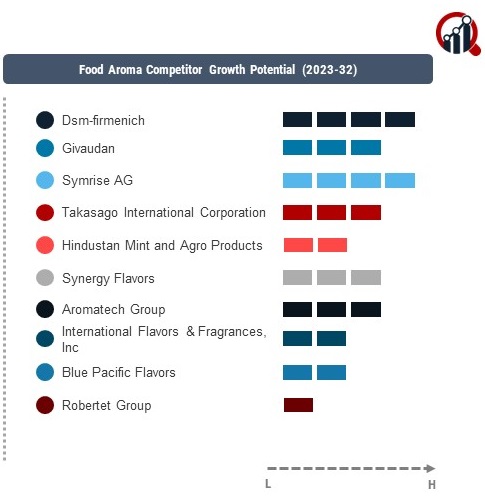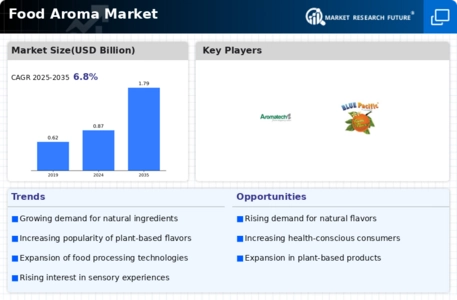Top Industry Leaders in the Food Aroma Market
 The food aroma market, a critical segment of the global food and beverage industry, is characterized by its focus on flavor compounds and additives that enhance the sensory appeal of food products. This market, driven by consumer preferences and technological advancements, has a competitive landscape that involves several key dimensions, including major players, strategic approaches, market share determinants, new entrants, industry updates, investment patterns, and recent developments, especially in 2023.
The food aroma market, a critical segment of the global food and beverage industry, is characterized by its focus on flavor compounds and additives that enhance the sensory appeal of food products. This market, driven by consumer preferences and technological advancements, has a competitive landscape that involves several key dimensions, including major players, strategic approaches, market share determinants, new entrants, industry updates, investment patterns, and recent developments, especially in 2023.
List of Key Players
- Dsm-firmenich
- Givaudan
- Symrise AG
- Takasago International Corporation
- Hindustan Mint and Agro Products
- Synergy Flavors
- Aromatech Group
- International Flavors & Fragrances, Inc (IFF)
- Blue Pacific Flavors
- Robertet Group
- Huabao International Holdings Limited
- MANE
Strategies Adopted
The strategies adopted by key players in the food aroma market are diverse and dynamic. These strategies typically include heavy investment in R&D, mergers and acquisitions (M&A), geographical expansion, and collaborations with food and beverage manufacturers. For instance, companies like Givaudan and Firmenich have continually expanded their product portfolios through strategic acquisitions, enabling them to tap into new market segments and enhance their technological capabilities.
Factors for Market Share Analysis
Market share in the food aroma sector is influenced by several factors, including product innovation, quality, brand reputation, pricing strategies, and the ability to meet changing consumer preferences. Furthermore, regulatory compliance and sustainable sourcing are becoming increasingly important as these factors influence consumer purchasing decisions.
New and Emerging Companies
The food aroma market is also witnessing the emergence of new and smaller players who are focusing on niche segments, such as organic and natural aromas, or specialized applications. These companies often bring innovative approaches to aroma creation and are agile in adapting to fast-changing market trends, thereby intensifying competition.
Industry News and Current Company Updates
In recent industry news, there has been a significant focus on natural and organic aromas, driven by increasing consumer awareness of health and wellness. Companies are responding to this trend by introducing new product lines and obtaining relevant certifications. Additionally, technological advancements, particularly in the areas of encapsulation and aroma recovery, are shaping product development and applications.
Investment Trends
Investment in the food aroma market is largely directed towards innovation in flavor technologies, sustainable practices, and expansion into emerging markets. There is a growing interest in investing in companies that are committed to environmentally friendly practices and that use sustainable raw materials. Moreover, venture capital investment is seen in startups that are innovating in the realm of natural and organic aromas.
Overall Competitive Scenario
The overall competitive scenario in the food aroma market is marked by intense competition among established players and new entrants. The market is somewhat consolidated with the major players holding significant market shares. However, the presence of numerous small and medium-sized enterprises (SMEs) adds to the competitive dynamics. Companies are competing not only in terms of product offerings but also in their sustainability practices and technological advancements.
Recent Developments
Several key developments have shaped the food aroma market. One of the most notable trends has been the increasing adoption of artificial intelligence (AI) and machine learning in aroma development. These technologies are being used to predict flavor combinations and consumer preferences, thereby enhancing the efficiency of product development.
Another significant development is the growing emphasis on sustainability in the sourcing of raw materials for aroma production. Companies are increasingly engaging in ethical sourcing practices and are exploring innovative methods to reduce their environmental footprint.
In addition, there has been a rise in demand for clean-label aromas, which has led companies to focus on transparency in their ingredient sourcing and manufacturing processes. This trend is in response to the growing consumer demand for products with natural ingredients and fewer artificial additives.
Regulatory changes have also impacted the market, with stricter guidelines being implemented for food additives, including aromas. Companies are adapting to these changes by ensuring compliance and focusing on the development of products that align with these new regulations.










